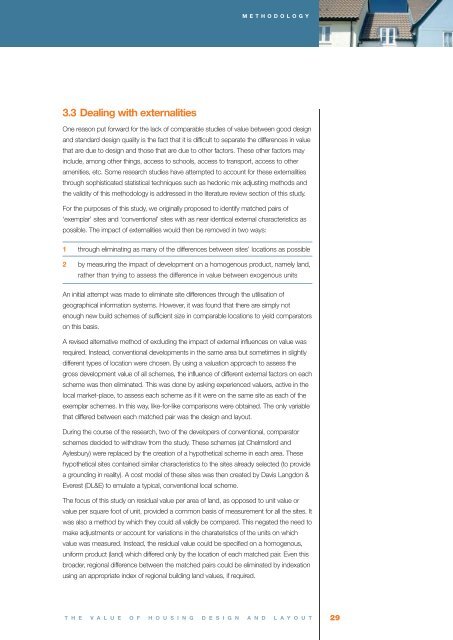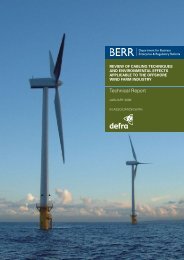The value of housing design and layout
The value of housing design and layout
The value of housing design and layout
You also want an ePaper? Increase the reach of your titles
YUMPU automatically turns print PDFs into web optimized ePapers that Google loves.
3.3 Dealing with externalities<br />
METHODOLOGY<br />
One reason put forward for the lack <strong>of</strong> comparable studies <strong>of</strong> <strong>value</strong> between good <strong>design</strong><br />
<strong>and</strong> st<strong>and</strong>ard <strong>design</strong> quality is the fact that it is difficult to separate the differences in <strong>value</strong><br />
that are due to <strong>design</strong> <strong>and</strong> those that are due to other factors. <strong>The</strong>se other factors may<br />
include, among other things, access to schools, access to transport, access to other<br />
amenities, etc. Some research studies have attempted to account for these externalities<br />
through sophisticated statistical techniques such as hedonic mix adjusting methods <strong>and</strong><br />
the validity <strong>of</strong> this methodology is addressed in the literature review section <strong>of</strong> this study.<br />
For the purposes <strong>of</strong> this study, we originally proposed to identify matched pairs <strong>of</strong><br />
‘exemplar’ sites <strong>and</strong> ‘conventional’ sites with as near identical external characteristics as<br />
possible. <strong>The</strong> impact <strong>of</strong> externalities would then be removed in two ways:<br />
1 through eliminating as many <strong>of</strong> the differences between sites’ locations as possible<br />
2 by measuring the impact <strong>of</strong> development on a homogenous product, namely l<strong>and</strong>,<br />
rather than trying to assess the difference in <strong>value</strong> between exogenous units<br />
An initial attempt was made to eliminate site differences through the utilisation <strong>of</strong><br />
geographical information systems. However, it was found that there are simply not<br />
enough new build schemes <strong>of</strong> sufficient size in comparable locations to yield comparators<br />
on this basis.<br />
A revised alternative method <strong>of</strong> excluding the impact <strong>of</strong> external influences on <strong>value</strong> was<br />
required. Instead, conventional developments in the same area but sometimes in slightly<br />
different types <strong>of</strong> location were chosen. By using a valuation approach to assess the<br />
gross development <strong>value</strong> <strong>of</strong> all schemes, the influence <strong>of</strong> different external factors on each<br />
scheme was then eliminated. This was done by asking experienced <strong>value</strong>rs, active in the<br />
local market-place, to assess each scheme as if it were on the same site as each <strong>of</strong> the<br />
exemplar schemes. In this way, like-for-like comparisons were obtained. <strong>The</strong> only variable<br />
that differed between each matched pair was the <strong>design</strong> <strong>and</strong> <strong>layout</strong>.<br />
During the course <strong>of</strong> the research, two <strong>of</strong> the developers <strong>of</strong> conventional, comparator<br />
schemes decided to withdraw from the study. <strong>The</strong>se schemes (at Chelmsford <strong>and</strong><br />
Aylesbury) were replaced by the creation <strong>of</strong> a hypothetical scheme in each area. <strong>The</strong>se<br />
hypothetical sites contained similar characteristics to the sites already selected (to provide<br />
a grounding in reality). A cost model <strong>of</strong> these sites was then created by Davis Langdon &<br />
Everest (DL&E) to emulate a typical, conventional local scheme.<br />
<strong>The</strong> focus <strong>of</strong> this study on residual <strong>value</strong> per area <strong>of</strong> l<strong>and</strong>, as opposed to unit <strong>value</strong> or<br />
<strong>value</strong> per square foot <strong>of</strong> unit, provided a common basis <strong>of</strong> measurement for all the sites. It<br />
was also a method by which they could all validly be compared. This negated the need to<br />
make adjustments or account for variations in the charateristics <strong>of</strong> the units on which<br />
<strong>value</strong> was measured. Instead, the residual <strong>value</strong> could be specified on a homogenous,<br />
uniform product (l<strong>and</strong>) which differed only by the location <strong>of</strong> each matched pair. Even this<br />
broader, regional difference between the matched pairs could be eliminated by indexation<br />
using an appropriate index <strong>of</strong> regional building l<strong>and</strong> <strong>value</strong>s, if required.<br />
T H E V A L U E O F H O U S I N G D E S I G N A N D L A Y O U T<br />
29

















